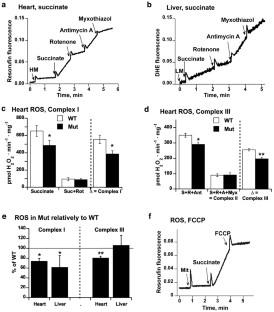Biochemistry (Moscow) ( IF 2.8 ) Pub Date : 2024-03-20 , DOI: 10.1134/s0006297924020081 Irina G. Shabalina , Daniel Edgar , Natalia Gibanova , Anastasia V. Kalinovich , Natasa Petrovic , Mikhail Yu. Vyssokikh , Barbara Cannon , Jan Nedergaard

|
Abstract
An increase in mitochondrial DNA (mtDNA) mutations and an ensuing increase in mitochondrial reactive oxygen species (ROS) production have been suggested to be a cause of the aging process (“the mitochondrial hypothesis of aging”). In agreement with this, mtDNA-mutator mice accumulate a large amount of mtDNA mutations, giving rise to defective mitochondria and an accelerated aging phenotype. However, incongruously, the rates of ROS production in mtDNA mutator mitochondria have generally earlier been reported to be lower – not higher – than in wildtype, thus apparently invalidating the “mitochondrial hypothesis of aging”. We have here re-examined ROS production rates in mtDNA-mutator mice mitochondria. Using traditional conditions for measuring ROS (succinate in the absence of rotenone), we indeed found lower ROS in the mtDNA-mutator mitochondria compared to wildtype. This ROS mainly results from reverse electron flow driven by the membrane potential, but the membrane potential reached in the isolated mtDNA-mutator mitochondria was 33 mV lower than that in wildtype mitochondria, due to the feedback inhibition of succinate oxidation by oxaloacetate, and to a lower oxidative capacity in the mtDNA-mutator mice, explaining the lower ROS production. In contrast, in normal forward electron flow systems (pyruvate (or glutamate) + malate or palmitoyl-CoA + carnitine), mitochondrial ROS production was higher in the mtDNA-mutator mitochondria. Particularly, even during active oxidative phosphorylation (as would be ongoing physiologically), higher ROS rates were seen in the mtDNA-mutator mitochondria than in wildtype. Thus, when examined under physiological conditions, mitochondrial ROS production rates are indeed increased in mtDNA-mutator mitochondria. While this does not prove the validity of the mitochondrial hypothesis of aging, it may no longer be said to be negated in this respect. This paper is dedicated to the memory of Professor Vladimir P. Skulachev.
中文翻译:

过早衰老 mtDNA 突变小鼠线粒体中 ROS 的产生增强
摘要
线粒体 DNA (mtDNA) 突变的增加以及随之而来的线粒体活性氧 (ROS) 产生的增加被认为是衰老过程的一个原因(“衰老的线粒体假说”)。与此相一致的是,mtDNA 突变小鼠积累了大量 mtDNA 突变,导致线粒体缺陷和加速衰老表型。然而,矛盾的是,mtDNA 突变体线粒体中 ROS 的产生率通常较早被报道为低于(而不是高于)野生型,因此显然否定了“线粒体衰老假说”。我们在这里重新检查了 mtDNA 突变小鼠线粒体中的 ROS 产生率。使用测量 ROS 的传统条件(不含鱼藤酮的琥珀酸盐),我们确实发现与野生型相比,mtDNA 突变体线粒体中的 ROS 较低。这种ROS主要是由膜电位驱动的反向电子流产生的,但由于草酰乙酸对琥珀酸氧化的反馈抑制,分离的mtDNA突变线粒体中达到的膜电位比野生型线粒体低33 mV,并且导致mtDNA 突变小鼠的氧化能力较低,这解释了 ROS 产生较低的原因。相反,在正常的正向电子流系统(丙酮酸(或谷氨酸)+苹果酸或棕榈酰辅酶A+肉碱)中,mtDNA突变体线粒体中线粒体ROS的产生较高。特别是,即使在活性氧化磷酸化过程中(生理上持续进行),mtDNA 突变体线粒体中的 ROS 率也高于野生型。因此,当在生理条件下检查时,线粒体 ROS 产生率确实在 mtDNA 突变线粒体中增加。虽然这并不能证明线粒体衰老假说的有效性,但在这方面可能不再被说是被否定的。本文谨纪念 Vladimir P. Skulachev 教授。



























 京公网安备 11010802027423号
京公网安备 11010802027423号